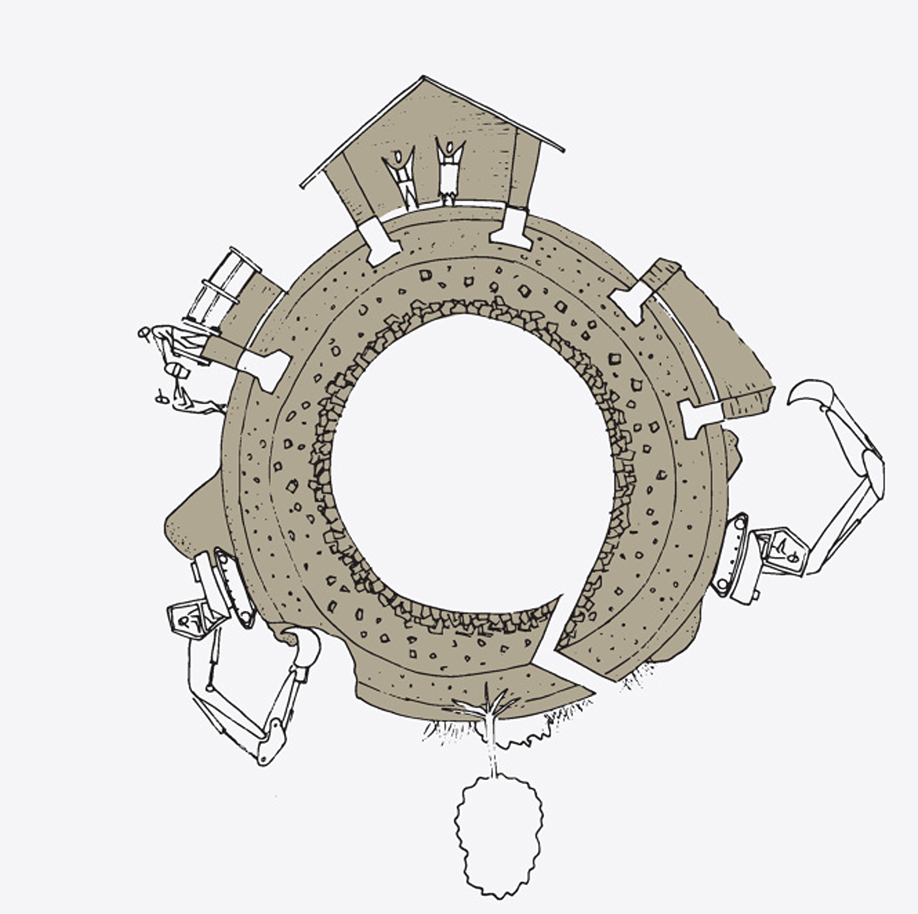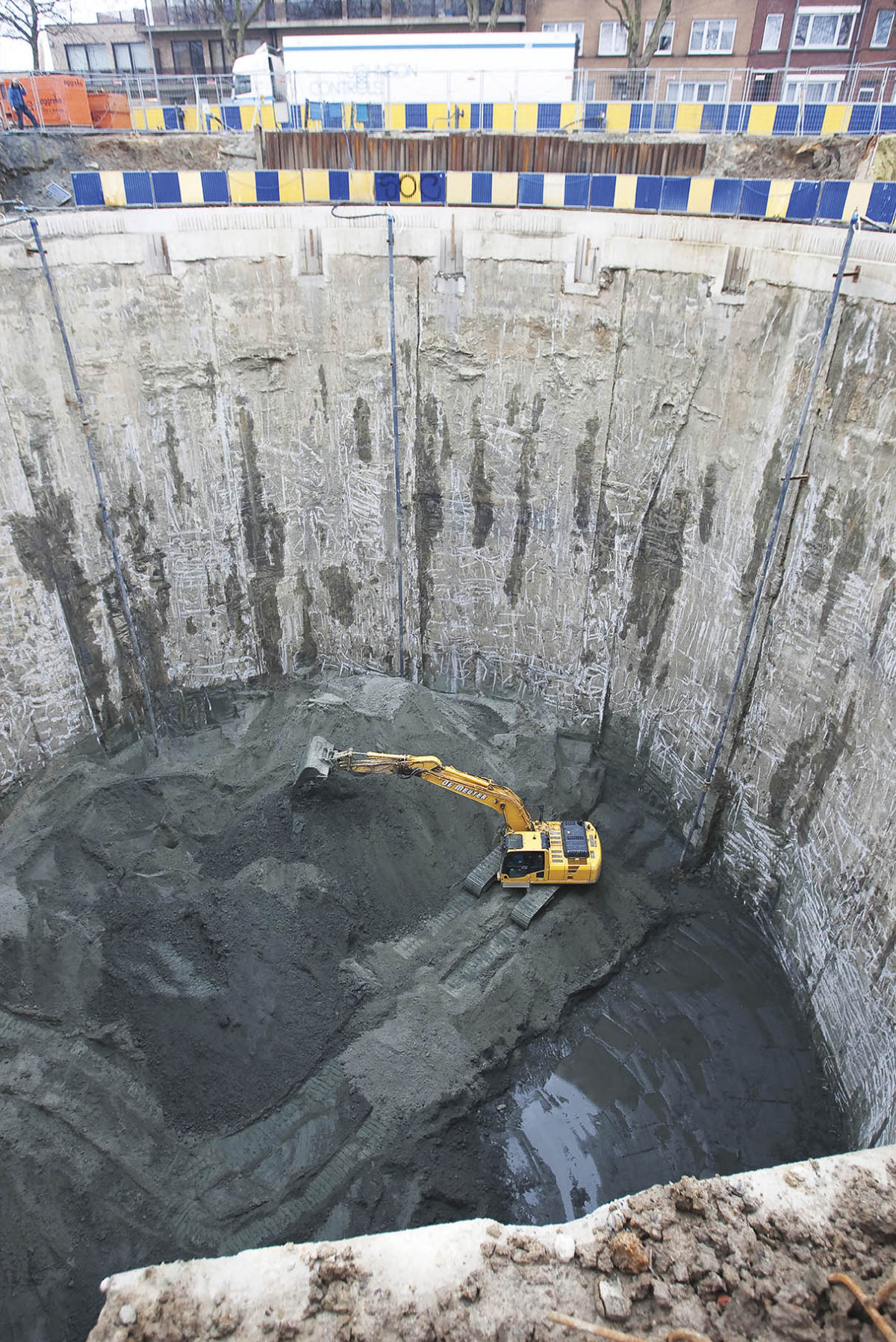CIRCULAR BXL – On Circularity and Craftsmanship
DESIGN STUDIO maib 14
| Semester | 1 |
| Start week | Tuesday sept 24 2019 18-20 h- studio on Wednesday starting 2nd of October |
| Reviews | Permanent evaluation, final reviews on the 18 December and 8 January |
| Credits | 15 |
| Studio tutors | Laurens Bekemans, Catherine Mengé |
Image ©Sven De Meuter
CONTENT
Climate adaptation requires a new attitude to materials, innovation in ecological and environmental engineering. Architects must research building materials and design the process of construction as much as its architectural outcome.
The earth is a closed system and our stay here is only temporary. That’s why we need to behave responsibly and consciously deal with everything that makes our stay possible on this planet. However, we have created a system that focuses on continuous, exponential growth, which means that products have to be produced in a more and more increasing amount. That is why many people already argue to organize our economy in a fundamentally different way: where it is no longer about ‘take, make and waste’ but about a circular economy where we re-use products and where waste becomes a ‘new’ raw material…
Within this context the pre-industrialized concept of a master-builder might just come back: a professional who goes back to the essence and creatively reuses material in smart spatial solutions. It reflects the idea of an integral approach to architecture, embedded in local context, local materials and local craftsmanship.

[1] Image from BC architects and studies
Circular economy is necessary and promising. Due to the energy, materials and climate transition, our environmental laws will soon become stricter. Long transport chains will push up the price of products. Residuals and waste will need to become the resources for tomorrow’s economy. This offers opportunities for shorter and closed production chains. These circular chains are most promising in places where many people live: in and around the city[2].
DESIGN APPROACH
Renewal and development of building E of TIR will be an unfolding and incremental process of adapting and improving the spaces to support a future public function of Brussels as well as the already existing logistical function.
The approach will focus firstly on analysing the city of Brussels from the perspective of a building material researcher. We’ll look at the city as a quarry, as a material and resources supplier. The research should look into low-tech materials such as (processed) reclaimed materials, demountable structures as well as earth, fibers, and other bio-based construction, orienting the projects efforts towards a bioregional economy.
The approach will focus on developing designs which work across the long, medium and short term. Working in this way enables an adaptability and responsiveness to change that more fixed and deterministic master-planning approaches cannot provide. This should not be a functionalist approach that starts by projecting ideas of specific use onto the space. It is not the programmatic approach that characterises modernist design methodology. It is an approach which allows and makes space for discontinuity, values and encourages coexistence and contingency, sees potential in different activities and communities operating next to each other at different times, of inhabitation and use of existing space.
The approach will use the construction process as a potent lever for social engagement, material research and climate adaptation. We often define the construction process through the notion of “the act of building” – a complex effort of a given community to generate infrastructure, encompassing all classes and skill sets, materials and technologies, with the power of change through action, story and result.
Maybe, through this approach, a new practice can develop which shows meaningful alternatives in the production, construction and use of human infrastructure.
AIM
- The sourcing: looking at the specificity of the Brussels territory from a social (craftmanship) point of view; walking in the neighbourhood, locating craftsmen, analysing their work and understanding potential. Looking at the specificity of the Brussels territory from a material point of view; what building materials can the city provide us with.
- The structure, services and skin: The aim is to design by the middle of the design studio a space which is enabling – a simple analogy might be a stage, which is itself basic but upon which an panoply of activities and uses is enabled and brought into a new relationship to context. This idea of the building as a spatial and architectural infrastructure leaves space for unforeseen ideas to take shape and influence the development of the project.
- The function: The final aim will be for the students to introduce in the building a public function. The exact brief of the function will only be communicated after the design of the structure, services and skin.
FOCUS
On one hand we focus on the sense of a place. We’ll try to understand and work with the specificity of the context. With this knowledge students develop a personal but site-anchored (spatial + socio-cultural) architectural project for the chosen site. Both in terms of functionality and materialization the project is celebrating the place.
On the other hand, we’ll look into the materiality and craftsmanship of architecture. Everything is embedded. The student is challenged to understand in a holistic way the site and develop affinities with local resources, construction techniques, bioclimatic principles and architectural typologies. These explorations will bring students closer to materials and their constructive features. Bridging the existing gap between architectural education and the craftsmanship of architecture.
SITE
The Building E of the TIR site which is located along the Brussels canal and is part of the larger canal area development.
The TIR (Transports Internationaux Routiers) buildings at Rue Dieudonné Lefèvre 2, 1020 Bruxelles – Brussel
are seen as one of the possible future hubs for the Brussels circular economic activities.
Read the full studio disciption here.

